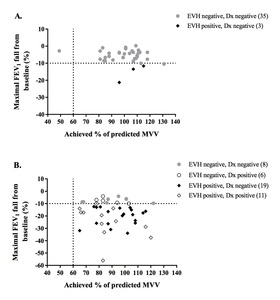Levai, Irisz Karolina, Hull, James H, Loosemore, Mike, Greenwell, Jon, Whyte, Greg, Dickinson, John W. (2016) Environmental influence on the prevalence and pattern of airway dysfunction in elite athletes. Respirology, 21 (8). pp. 1391-1396. ISSN 1440-1843. (doi:10.1111/resp.12859) (KAR id:57161)
|
PDF
Author's Accepted Manuscript
Language: English |
|
|
Download this file (PDF/534kB) |
Preview |
| Request a format suitable for use with assistive technology e.g. a screenreader | |
|
Image (JPEG) (Figure 1)
Supplemental Material
Language: English |
|
|
Download this file (Image (JPEG)/183kB) |
![[thumbnail of Figure 1]](https://kar.kent.ac.uk/57161/8.hassmallThumbnailVersion/Levai%20Respirology%20Figure1.jpg)  Preview |
| Request a format suitable for use with assistive technology e.g. a screenreader | |
|
PDF
Publisher pdf
Language: English Restricted to Repository staff only |
|
|
|
|
| Official URL: https://doi.org/10.1111/resp.12859 |
|
Abstract
BACKGROUND AND OBJECTIVE: Elite swimming and boxing require athletes to achieve relatively high minute ventilation. The combination of a sustained high ventilation and provocative training environment may impact the susceptibility of athletes to exercise-induced bronchoconstriction (EIB). The purpose of this study was to evaluate the prevalence of EIB in elite Great British (GB) boxers and swimmers. METHODS: Boxers (n=38, mean age: 22.1 ± 3.1 years) and swimmers (n=44, mean age: 21.1 ± 2.6 years) volunteered for the study. Athletes completed an exercise-induced respiratory symptom questionnaire, baseline assessment of fraction of exhaled nitric oxide (FeNO), maximal spirometry manoeuvres and a eucapnic voluntary hyperpnoea (EVH) challenge. EIB was confirmed if forced expiratory volume in 1 s (FEV1 ) reduced by ≥10% from baseline at two time points post-EVH challenge. RESULTS: The prevalence of EIB was greater in elite swimmers (30 of 44; 68%) than in boxers (3 of 38; 8%) (P<0.001). Twenty-two out of the 33 (67%) EVH-positive athletes had no prior diagnosis of asthma/EIB. Moreover, 12% (6 of 49) of the EVH-negative athletes had a previous diagnosis of asthma/EIB. We found a correlation between FeNO and FEV1 change in lung function post-EVH challenge in swimmers (r=0.32; P=0.04) but not in boxers (r=0.24; P=0.15). CONCLUSION: The prevalence of EIB was ninefold greater in swimmers when compared with boxers. Athletes who train and compete in provocative environments at sustained high ventilation may have an increased susceptibility to EIB. It is not entirely clear whether increased susceptibility to EIB affects elite sporting performance and long-term airway health in elite athletes.
| Item Type: | Article |
|---|---|
| DOI/Identification number: | 10.1111/resp.12859 |
| Uncontrolled keywords: | asthma, athlete's care, exercise‐induced bronchoconstriction, sport, training environment |
| Subjects: |
R Medicine > RC Internal medicine > RC1200 Sports medicine R Medicine > RC Internal medicine > RC1235 Physiology of sports |
| Institutional Unit: | Schools > School of Natural Sciences > Sports and Exercise Science |
| Former Institutional Unit: |
Divisions > Division of Natural Sciences > Sport and Exercise Sciences
|
| Depositing User: | John Dickinson |
| Date Deposited: | 09 Sep 2016 13:57 UTC |
| Last Modified: | 20 May 2025 09:49 UTC |
| Resource URI: | https://kar.kent.ac.uk/id/eprint/57161 (The current URI for this page, for reference purposes) |
- Link to SensusAccess
- Export to:
- RefWorks
- EPrints3 XML
- BibTeX
- CSV
- Depositors only (login required):


 https://orcid.org/0000-0002-1824-7402
https://orcid.org/0000-0002-1824-7402 Altmetric
Altmetric Altmetric
Altmetric
